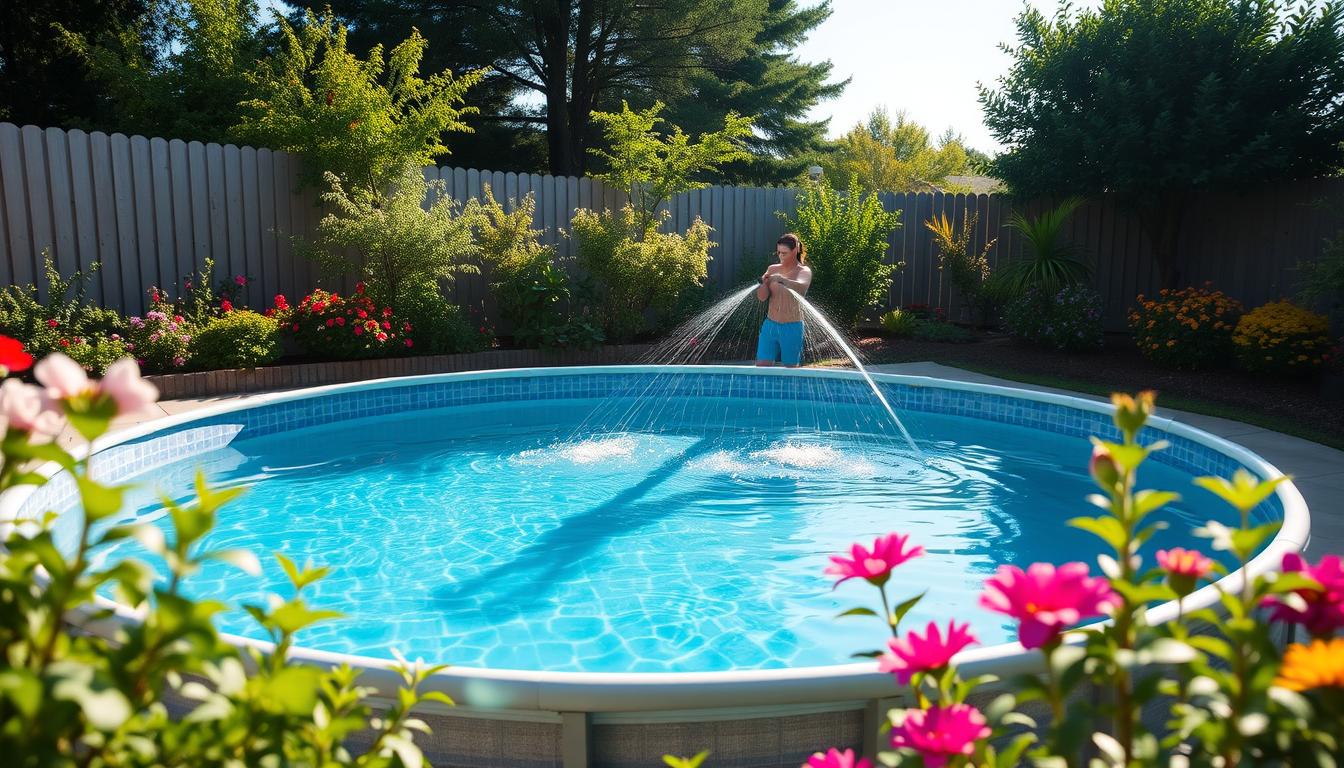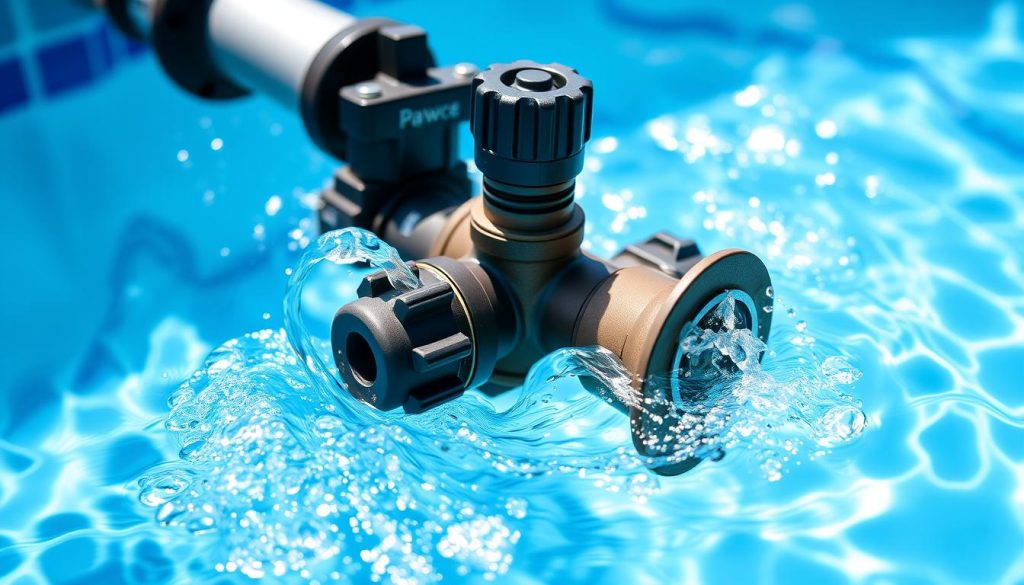
Pool experts suggest backwashing your above ground pool when pressure rises 8-10 pounds above the clean “startup” pressure. This highlights the need for regular filter cleaning to keep your pool clean and enjoyable.
Backwashing cleans your pool’s filter without manual scrubbing. It’s a quick, crucial part of pool maintenance. This process flushes out debris, keeping your filter efficient and your water clearer.
This guide will teach you how to backwash an above ground pool step-by-step. You’ll gain the knowledge to handle this important task confidently. We’ll also cover the benefits of regular backwashing.
Learn the signs that indicate it’s time to clean your pool filter. With this info, you’ll keep your pool in top shape all season long.
Key Takeaways
- Backwashing is a quick and effective way to clean your above ground pool filter
- Regular backwashing helps maintain clean, clear pool water
- A pressure rise of 8-10 pounds above the clean “startup” pressure indicates it’s time to backwash
- Backwashing typically takes just a few minutes to complete
- Proper backwashing is crucial for maintaining an efficient and long-lasting pool filter
Understanding the Importance of Backwashing Your Above Ground Pool
Backwashing is key to maintaining a clean above ground pool. It reverses water flow through the filter to remove debris. This process ensures optimal water circulation and filtration for crystal-clear pool water.
Benefits of Regular Backwashing
Regular backwashing offers many benefits for your pool and filtration system. It removes trapped debris, preventing clogs and maintaining efficient water flow. This ensures even chemical distribution and keeps the water clean.
Backwashing also extends your pool filter’s lifespan. It prevents excessive contaminant buildup, which can strain the system. Regular backwashing keeps your filter working well and helps avoid costly repairs.
Signs Your Pool Filter Needs Backwashing
It’s crucial to spot signs that your pool filter needs backwashing. An increase in filter pressure is a clear indicator. Backwash when the pressure gauge reads 8-10 PSI above normal.
Reduced water flow from return jets may signal a clogged filter. Cloudy water despite regular chemical treatment could mean ineffective contaminant removal. These signs indicate your filter needs backwashing.
| Filter Type | Backwashing Frequency | Filter Lifespan |
|---|---|---|
| Sand Filter | Every 2 weeks or when pressure rises 8-10 PSI above normal | 5-7 years before sand replacement |
| Cartridge Filter | When pressure is 8-10 PSI over baseline | 1-3 years before cartridge replacement |
| DE Filter | Backwash when pressure rises 8-10 PSI above normal | DE grids can last over 10 years with proper care |
Maintaining a regular backwashing schedule based on your filter type and pressure readings is key to ensuring optimal filtration and prolonging the life of your pool filter.
Knowing when to backwash helps keep your above ground pool clean. Regular maintenance ensures your pool stays enjoyable for years to come.
Preparing to Backwash Your Above Ground Pool Filter
Proper preparation is key for backwashing your pool filter. Gather all necessary equipment and check valve positions. This ensures a smooth process and helps avoid potential issues.
Gathering Necessary Equipment
Collect all items needed for backwashing your above ground pool filter. You’ll need a backwash hose and a clean area for waste water. Ensure the hose is long enough and free of damage.
Ensuring Proper Valve Positioning
Check your filter’s multiport valve or backwash valve position. Refer to the manual for correct settings. Proper positioning prevents damage to your filter and pool system.
Turn off the pump and connect the backwash hose to the waste port. Ensure a tight connection to avoid leaks. Place the hose’s other end in the drainage area, away from the pool and structures.
Proper priming is crucial for effective water circulation and filtration maintenance. Follow the six steps outlined for priming the pump to ensure optimal operation.
Double-check valve positioning and hose connections before starting. This final check helps prevent unexpected issues during backwashing. It ensures a smooth process for maintaining a clean pool environment.
| Filter Type | Backwash Frequency | Replacement Timeframe |
|---|---|---|
| Sand Filters | Every 2 weeks | Every 5-7 years |
| Cartridge Filters | As needed | Every 1-3 years |
| D.E. Filters | Every month | Grids last 10+ years |
Regularly check your pool filter’s pressure gauge for optimal performance. High pressure indicates cleaning is needed. Low pressure after cleaning might mean it’s time for replacement.
Follow these pool care tips and use your filter’s backwash valve correctly. You’ll enjoy a sparkling clean pool all season long.
Step-by-Step Guide: How to Backwash an Above Ground Pool
Backwashing your above ground pool is vital for regular maintenance. This process cleans your pool filter effectively. Let’s explore how to backwash your above ground pool.
Initiating the Backwash Process
Start by turning on your pool pump. Let it run for a few minutes to dislodge trapped debris. Watch the pressure gauge during this time.
A high reading shows your filter needs backwashing. This is a key indicator for when to start the process.

Monitoring Water Clarity During Backwash
Watch the sight glass or discharge water as you backwash. The water may look cloudy at first but should clear up gradually.
Continue backwashing until the water runs clear. This usually takes about 2-3 minutes.
A helpful pool care tip is to backwash your filter when the pressure gauge reads 8-10 psi above the normal operating pressure, which is usually between 10 and 20 psi for most pool filters.
Completing the Backwash Cycle
After the water clears, turn off the pump. Set the multiport valve to “Rinse”. This step settles the filter media and removes leftover debris.
Turn the pump back on for 30 seconds to 1 minute. This rinse cycle is crucial for thorough cleaning.
| Filter Type | Backwash Frequency | Additional Maintenance |
|---|---|---|
| Sand Filters | Every 2 weeks | Replace sand every 5-7 years |
| DE Filters | Every month | Add DE powder after backwashing |
| Cartridge Filters | When pressure increases 8-10 psi | Replace cartridges every 1-2 years |
Rinsing the Filter
After rinsing, turn off the pump. Set the multiport valve back to “Filter”. For DE filters, add the right amount of DE powder.
Turn the pump on and check the pressure gauge. It should return to the normal range, showing a clean filter.
Regular backwashing keeps your pool clean and healthy. Follow these steps for a sparkling swimming environment your family will love.
Maintaining Your Above Ground Pool After Backwashing
Proper pool care is vital after backwashing your above ground pool filter. Skim the pool surface daily to remove floating debris. Brush the walls and floor weekly to prevent algae growth.
Test pH and chlorine levels twice a week. Keep pH between 7.2 and 7.6. Maintain chlorine between 1.0 and 3.0 ppm. This balance ensures clean water and reduces the need for frequent backwashing.
Keep water level halfway up the skimmer opening for optimal filtration. Monitor the filter pressure gauge regularly. Backwash sand filters every 1-2 weeks or when pressure rises 7-10 psi.
Add DE powder after each backwash for DE filters. Replace grids as needed. Clean cartridge filters every few weeks. Replace them annually or as required.
Use algaecides to prevent cloudy water and algae growth. Avoid household bleach for shock treatment. It lacks stabilizers and may cause imbalances.
Schedule an annual checkup with a pool professional. Address issues promptly. Follow a consistent maintenance schedule for a clean, healthy swimming environment all season long.







